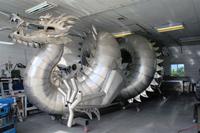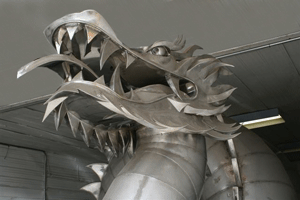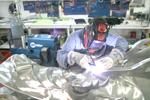Contributing Writer
- FMA
- The Fabricator
- FABTECH
- Canadian Metalworking
Categories
- Additive Manufacturing
- Aluminum Welding
- Arc Welding
- Assembly and Joining
- Automation and Robotics
- Bending and Forming
- Consumables
- Cutting and Weld Prep
- Electric Vehicles
- En Español
- Finishing
- Hydroforming
- Laser Cutting
- Laser Welding
- Machining
- Manufacturing Software
- Materials Handling
- Metals/Materials
- Oxyfuel Cutting
- Plasma Cutting
- Power Tools
- Punching and Other Holemaking
- Roll Forming
- Safety
- Sawing
- Shearing
- Shop Management
- Testing and Measuring
- Tube and Pipe Fabrication
- Tube and Pipe Production
- Waterjet Cutting
Industry Directory
Webcasts
Podcasts
FAB 40
Advertise
Subscribe
Account Login
Search
Eagles, dragons: Stainless steel takes on many forms
Artist uses GTAW to create 'shock and awe' art
- By John Luck
- October 14, 2008
- Article
- Arc Welding
A few years ago Kevin Stone, a senior fabricator, decided to combine his years of welding experience with his innate artistic ability and began creating stainless steel sculptures on a large scale. While people make the pilgrimage to Stone's yard in Chilliwack, B.C., to see the "Power of Flight," a 12-ft. tall, 18-ft.-long stainless steel eagle with a 41-ft. wingspan, Stone is busy inside his studio working on his latest project: an 85-ft.-long Chinese dragon.
With price tags of more than $3 million, Stone's sculptures are designed to weather the elements and never lose their shine. His objective is to create "shock and awe artwork … beauty on a large scale." To achieve this vision, he works with stainless steel, which he considers to be one of the more difficult metals to work with.
"Very few people can weld thin stainless," Stone said. "It will oxidize quickly, overheat, and burn through. It requires polishing to bring out its beauty, which is very labor-intensive. Very few people work with it. However, it's worth the effort. Once it's polished, it can be out in the elements, and it won't corrode, rust, or lose its mirrorlike quality. My vision is for my sculptures to be mounted over water to bring out the reflective qualities and use colored lights for effect."
About 14 months into the "Chinese Imperial Water Dragon" (Figure 1), Stone already has used 1,800 sq. feet of 16-gauge 304 stainless steel and expects to use another 1,800 sq. ft. before he's done.
The Creative Process
When beginning a new sculpture, Stone conducts some preliminary research and design, but he builds primarily from his imagination. "I have a blueprint in my head that I follow," he said. "I visualize five to 10 steps ahead of what I'm working on. I picture what the overall shape will be and try to think of something that will fit inside that shape, yet be structurally strong."
To help with fit-up and save both time and material, Stone first works out the details on paper. After he finishes one piece of stainless, he cuts a piece of paper to represent the next piece and ensure it fits perfectly before transferring it to a piece of stainless.
Stone shapes the pieces by hand and then tack-welds them into place with his Miller Dynasty® gas tungsten arc welding (GTAW) machine. He first places the welds several inches apart. When Stone is happy with the fit-up, he adds more tack welds between the existing welds until there are welds about every half-inch. He eventually finish-welds the pieces together, welding a 10-in. section in one place and then moving to another section. This helps to minimize the heat input and to ensure proper fit. He finishes by grinding down the welds and polishing the pieces.
Equipment
Stone had particular criteria when choosing the equipment to create his sculpture. His GTAW machine had to have a nice arc start, so he could start off slowly and still maintain good heat control. "With my sculptures, there are few welds in a flat position. I weld in the most awkward positions, conditions, and shapes you can imagine."
For the 16-ga. material he works with, Stone usually sets his machine to 160 amps and prefers a thumb control (Figure 2) rather than a foot control. He also chose a water-cooled torch because it keeps his hand cool and allows him to use a smaller torch.
Advice for Aspiring Metal Sculptors
Other than picking the right equipment, Stone has some advice for the aspiring metal sculptor.

Figure 1Click image to view larger The "Chinese Imperial Water Dragon" slowly takes shape in Stone's studio. The Sculpture comprises approximately 3,600 sq. ft. of 304 stainless steel and is priced at more than $1 million.
"Practice your trade skills," he advised. "I have 18 years of welding experience, which allows me to weld stainless. It's not easy and takes a lot of practice.
"If you're doing any artwork, practice drawing. It helps you visualize. Drawing can actually help sculpting dramatically because it helps lock in and define your vision."
Stone also noted two common mistakes people who GTAW make. "To become steadier, many people tend to hold their breath, but this can have the opposite effect. Relax and breathe normally. Also, a gentle grip makes for a steadier hand. Hold the torch firmly but not too tightly, or fatigue will set in and lead to shaking."
GTAW Stainless
When GTAW stainless, whether for a sculpture or on the job, keeping in mind a few key points can help you achieve a cosmetically appealing and sound weld.
- Because stainless steel does not adequately dissipate heat, maintaining proper heat input when welding is critical (Figure 3). Too much heat can lead to warping, embrittlement, or rust. As little as 5 amps too much can damage stainless steel's properties. There are, however, several ways to control heat input:
- Good fit-up. Adding filler metal to fill gaps puts more heat into the part, so good fit-up is important. It's impossible to add a lot of filler metal and keep energy out of the part.
- Use the correct filler metal. The filler metal diameter should be thinner than the base metal. If it's thicker than the base metal, too much heat is needed to melt the filler metal. The filler metal also should match the base metal alloys to maintain consistent mechanical and corrosion properties.
- Choose the right tungsten size. You can't weld precisely on 1/16-in. material with a 1/8-in. tungsten. Use the right tungsten diameter based on your amperage. Check the manufacturer's recommendations for the proper size.
- Use the correct tungsten geometry (Figure 4). The tungsten's shape plays a role in the weld's width and penetration. In welding stainless steel, the sharper the tungsten, the wider and less penetrating the bead. On a sharper point (ground to a taper length that is more than 2.5 times the electrode diameter), the arc tends to fan out, which creates a wider heat-affected zone (HAZ). With a blunter point (less than 2.5 times the electrode diameter), the arc comes straight down with less flaring for a deeper, thinner bead and thinner HAZ.
- Use a fingertip or foot control. You need to be able to start the arc and adjust the amperage from the beginning to the end of the weld. Set the machine to the desired amperage, which should be just a bit more power than you need. If your machine is fairly accurate, you need to adjust the fingertip or foot control just a little bit to adjust welding output.
- Start with low amperage and allow the puddle to form. Then back off 2 or 3 amps and add filler.
- Maintain the correct puddle size. The weld puddle should be the thickness of the base metal. If the puddle grows too large, turn down the heat.
- Eliminate craters. To do this, ease down the current at the end of the weld and add filler metal until the puddle solidifies. Use your torch's fingertip or foot pedal control or your machine's sequencer.
- Monitor gas flow. Keep the gas flowing and directed at the puddle until the orange color fades. The postflow also cools the puddle and the tungsten. Moving the torch too fast can blow gas away from the tungsten, turn it black, and make it more difficult to start next time.
- Use pulsing. To control heat input, use a welder with DC pulsing capability. In pulsing, the current transitions between a high peak amperage and a low background amperage that maintains the arc but allows the puddle to cool. The peak current provides good penetration, but the background current allows the weld puddle to cool slightly, preventing warping, embrittlement, and carbide precipitation.
Pulses per second (PPS) is simply how many times the machine will complete one pulsing cycle in one second. Increasing the number of pulses per second produces a smoother ripple effect in and narrows the weld bead. Reducing the number of PPS widens the weld bead. Pulsing also helps agitate the puddle and release any porosity or gas trapped in the weld.
Some beginning welders use a slow pulsing rate (perhaps 0.5 to 1 PPS) to help them develop a rhythm for adding filler metal. For welding carbon or stainless steel, use a rate of 100 to 500 PPS. Start at 100 and work upward.
- Higher pulsing (generally above 100 PPS) increases puddle agitation, which in turn produces a better grain molecular structure within the weld. High-speed pulsing also constricts and focuses the arc. This increases arc stability, penetration, and travel speeds, and it produces a smaller HAZ (Figure 5).
High-speed pulsed GTAW (Figure 4) requires using an inverter. Conventional GTAW technology limits pulsing to a relatively narrow range of 0.25 to 10.0 PPS, whereas inverter technology enables pulsing at up to 5,000 PPS.
- One final tip: As Stone advised, practice, practice, practice. Check your settings and technique on a test piece beforehand. GTAW stainless steel is an art, but it's one that can be learned and enjoyed.
About the Author
John Luck
1635 W. Spencer St. P.O. Box 1079
Appleton, WI 54912
800-426-4553
About the Publication
Related Companies
subscribe now

The Welder, formerly known as Practical Welding Today, is a showcase of the real people who make the products we use and work with every day. This magazine has served the welding community in North America well for more than 20 years.
start your free subscription- Stay connected from anywhere

Easily access valuable industry resources now with full access to the digital edition of The Fabricator.

Easily access valuable industry resources now with full access to the digital edition of The Welder.

Easily access valuable industry resources now with full access to the digital edition of The Tube and Pipe Journal.
- Podcasting
- Podcast:
- The Fabricator Podcast
- Published:
- 04/16/2024
- Running Time:
- 63:29
In this episode of The Fabricator Podcast, Caleb Chamberlain, co-founder and CEO of OSH Cut, discusses his company’s...
- Trending Articles
Sheffield Forgemasters makes global leap in welding technology

ESAB unveils Texas facility renovation

Engine-driven welding machines include integrated air compressors

The impact of sine and square waves in aluminum AC welding, Part I

Compact weld camera monitors TIG, plasma processes

- Industry Events
16th Annual Safety Conference
- April 30 - May 1, 2024
- Elgin,
Pipe and Tube Conference
- May 21 - 22, 2024
- Omaha, NE
World-Class Roll Forming Workshop
- June 5 - 6, 2024
- Louisville, KY
Advanced Laser Application Workshop
- June 25 - 27, 2024
- Novi, MI




























